Have you been interested in building decentralized applications (dapps) but weren’t sure how to store related data? If so, you need to learn about blockchain storage and how to use it instead of centralized alternatives. After all, we must avoid centralized solutions to create a fully transparent and honest future, and blockchain tech is the solution. However, like all emerging tech, blockchain – especially when referring to storage – has some challenges it needs to overcome. Fortunately, several projects have already managed to tackle these challenges and have, in turn, addressed the storage concern. So, if you’d like to explore blockchain storage further, including what it is, how to use it, and what solutions to utilize in your development endeavors, read on!
As we move on, we’ll first answer the “what is blockchain storage?” question. This is where you’ll learn the basics of this disruptive decentralized technology. Furthermore, in the upcoming section, you’ll find out about the new iteration of the web that blockchain technology has made possible. We’ll also do our best to clear up some of the “blockchain as storage” confusion. For that purpose, we’ll address the question, “can blockchain be used for storage?”. Moreover, we’ll make sure you understand where blockchain data is stored. Lastly, we’ll take a closer look at some useful blockchain storage tools for dapp developers, and if you want to take the ultimate solution for a spin, make sure to create your free Moralis account!

What is Blockchain Storage?
Blockchain storage is a decentralized storage solution that enables users to truly own their data and doesn’t have a single point of failure. Furthermore, it focuses on utilizing or at least working hand-in-hand with blockchain technology.
Note: The entire industry evolving around blockchains is rather new and not institutionalized. Thus, there are many semantic inconsistencies. So, you may also encounter content referring to blockchain storage as the blockchains themself. We can’t say that this is incorrect. After all, at its core, blockchains are unique kinds of databases. Moreover, although blockchain storage systems or solutions focus on storing more extensive data (documents, images, websites, applications, videos, etc.), they do so not directly on the blockchain.
With the above notation in mind, there’s another term for blockchain storage that may be more appropriate, namely, Web3 storage. This also means that to make the most out of today’s discussion about blockchain and storage, you ought to know what Web3 is. Web3 takes the read-write functionality of its predecessor and upgrades it with ownership. While Web2 continues to be the mainstream web, Web3 is evolving fast and onboards new users daily. Nonetheless, let’s repeat that blockchain technology and crypto principles are at the core of this new generation of the internet. Moreover, make sure to have a quick look at the image below, where you can see all three generations of the internet:
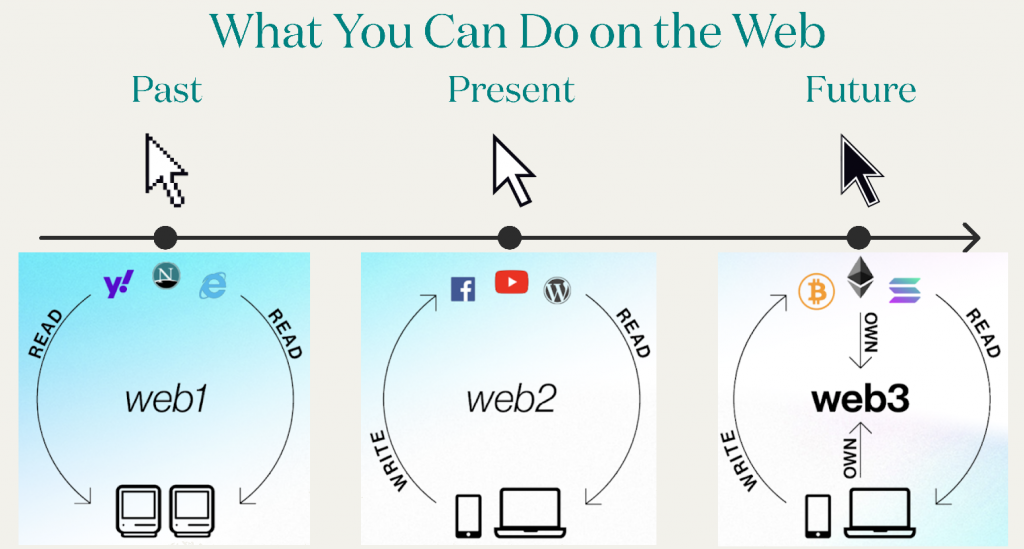
To make the “ownership” part come true, centralized storage solutions like Dropbox, Google Cloud, etc., are not suitable. With these centralized storage solutions, you can never be certain if your privacy is just that – private. Further, it’s difficult to be sure if your privacy is abused. Consequently, legacy cloud storage solutions require a great deal of trust. This doesn’t work with Web3, which is all about honesty, transparency, and immutability.
Can Blockchain Be Used for Storage?
Can blockchain be used for storage? In short, the answer is “yes”. However, it requires some further explanation. As you probably already know, Bitcoin was the first blockchain and crypto asset that introduced this new tech to the world. This was when the definition of blockchain as an immutable, distributed digital ledger was coined. Following this definition, blockchain is a special kind of database. It was obviously intended to store specific data; however, that only includes hashed transactions and smart contracts (pieces of code). Why? Because this type of data is minimal in size. It is technically and economically impossible to store larger data on blockchains such as Bitcoin, Ethereum, BNB Chain, etc.
However, there are protocols and projects that focus on using blockchain technology to deliver all-around storage solutions. We’ll mention some of the leading ones later on and even take a closer look at two of them. Moreover, these projects, in some cases, tend to create their own blockchains, whether to use them to store data or serve governance/incentive purposes. Typically, they also use some sort of “blockchain-like” or hybrid tech that applies the same decentralization and distribution principles as various blockchains. Thus, these hybrid solutions are used to store larger data, while blockchains can store smaller encrypted data that points to larger data.
Blockchain Storage Problem
This section is for those who wonder why we can’t simply store all data on programmable chains such as Ethereum. To elaborate on that dilemma, we need to dive a bit deeper into the storage concern regarding blockchain. Let’s first point out that blockchains need nodes to operate. These nodes are computers that contribute to the integrity of the chain. Furthermore, there are different types of nodes; however, full nodes play the most important role. These types of nodes contain the entire copy of the current blockchain. This means that a single machine must be capable of storing all the stored data in the particular blockchain. In addition, the larger number of machines involved, the more a blockchain is distributed and decentralized.

As the blockchain is immutable, no data can be deleted, which is another “blockchain storage problem”. When a chain is popular, and numerous on-chain transactions occur, the priority is to ensure enough storage space for the blockchain’s transaction hashes. That said, processing large files/data would slow down the entire network.
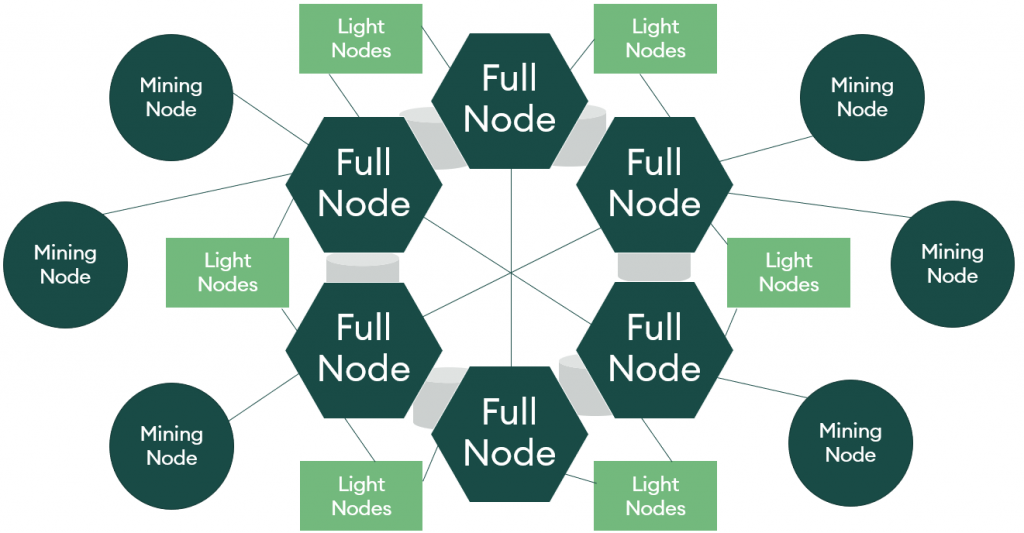
All in all, there are two core storage concerns with blockchain:
- Ensuring the ability of nodes to store only the essential data (transaction hashes and smart contracts) in the long run.
- Not compromising the level of decentralization by keeping the node requirements reasonably accessible.
However, as mentioned above, there are already several protocols focusing on creating reliable blockchain data storage solutions. Thus, any blockchain storage problem will likely be a thing of the past in the near future.
Blockchain Data Storage – Where is Blockchain Data Stored?
When it comes to data storage on blockchain, data is stored on a network of computers instead of on a single server. As you can imagine, the details of the mechanics of these types of solutions vary greatly. Moreover, each blockchain storage protocol is trying to come up with a unique twist that will make it the ultimate solution. However, currently, a non-blockchain protocol, IPFS, is the leading option. Thus, many devs use IPFS for NFT metadata and NFT-representing files. Ultimately, IPFS is currently the most popular blockchain storage system alternative. As such, we will take a closer look at this decentralized protocol in the next section.
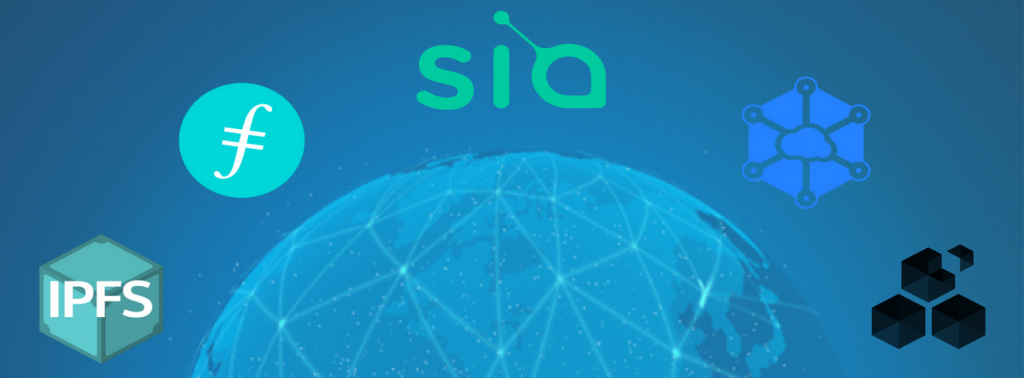
Still, several other reputable projects deserve your attention. Of course, they all take a unique approach to ensure redundancy, efficiency, and a proper level of decentralization. Aside from IPFS, which is a breed of its own, the projects listed below are at the frontline regarding blockchain and storage development:
- Crust Network
- Holo (HOT)
- Arweave (AR)
- Sia
- Storj
- Filecoin (FIL)
Among the above projects, many devs currently find Filecoin the most interesting alternative. Its close connection to IPFS surely plays an important role. After all, IPFS has already managed to gain a positive reputation as it has proven to be a reliable blockchain data storage alternative. However, we still encourage you to explore other solutions from the above list to determine your favorite.
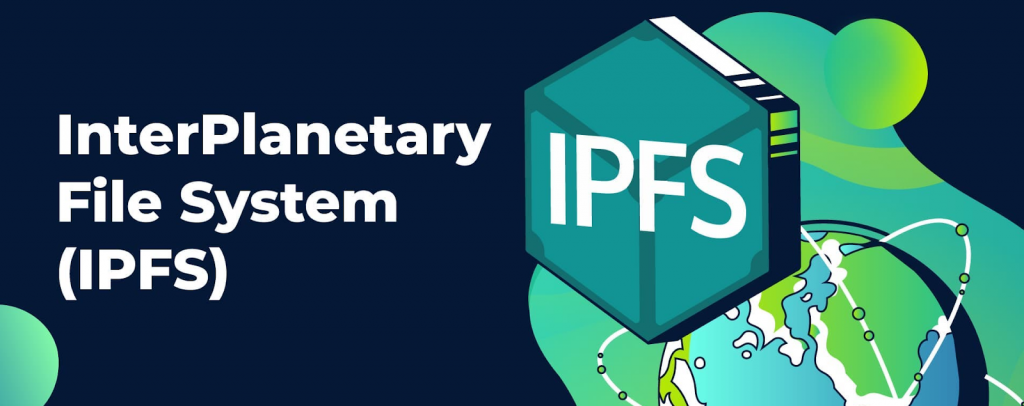
Meet IPFS
IPFS (InterPlanetary File System) is a distributed storage protocol/system, and Protocol Labs is the organization behind this peer-to-peer (P2P) hypermedia protocol. Furthermore, Protocol Labs designed IPFS for uploading, storing, and accessing data, files, websites, and applications. Their aim was to make the new generation of the internet open, resilient, and upgradeable.
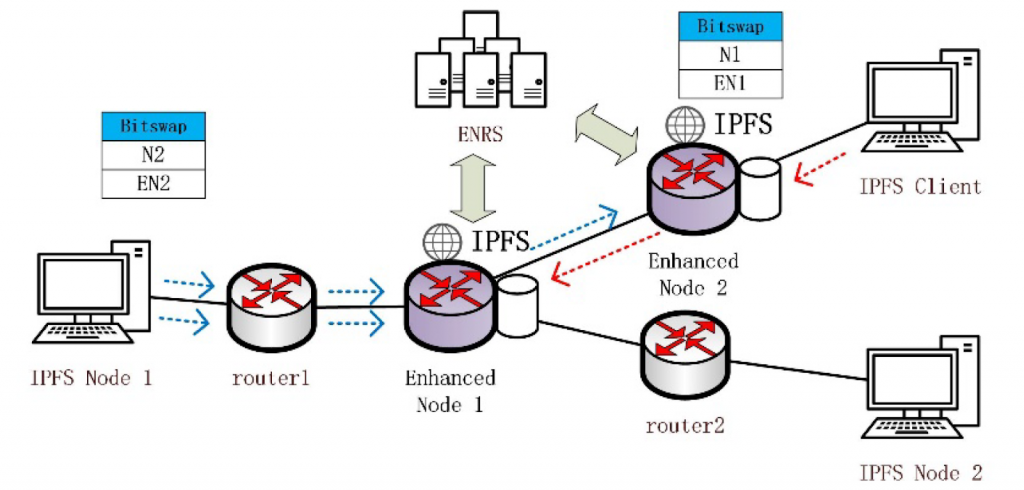
IPFS enables users to host and access content in a decentralized manner. Within this P2P file-sharing protocol, every user operator hosts a portion of the overall data. This partitioning is IPFS’ unique and innovative solution. Compared to the location-based HTTP system, IPFS introduced a content-addressing solution. Thus, users get to search based on the actual content rather than its location. The latter is possible thanks to unique content identifiers (CIDs). Essentially, every piece of content inside the IPFS ecosystem has its unique CID (hash). Hence, IPFS utilizes these cryptographic hashes when you want to find specific data. Aside from content addressing, IPFS also links pieces of content together by generating IPLD Merkle DAGs.
Note: To explore IPFS in more detail, make sure to visit this protocol’s official documentation.

Meet Filecoin
Filecoin is a reputable open-source blockchain storage solution with a cloud storage marketplace, protocol, and incentive layer. As mentioned previously, the Filecoin network is a sort of blockchain-focused upgrade of IPFS, offering a very similar decentralized and secure data storage and retrieval solution.
Furthermore, Filecoin allows everyone to join and participate as storage providers. With this freedom of supply, the protocol ensures hyper-competitive storage prices. This also brings a large number of diverse storage providers and developers to the Filecoin network. As a result, the network becomes more robust and reliable. Moreover, via the above-explained IPFS’ content addressing and cryptographic storage proofs, Filecoin offers provable security and authenticity. It verifies that the protocol properly and securely stores the data over time. In addition, Filecoin allows users to customize redundancy, retrieval speed, and cost strategies. Hence, it’s no wonder that Filecoin is a fast-growing ecosystem of providers, tools, libraries, and integrations.

Blockchain Storage Tools
Now that you know what blockchain storage solutions are, it’s time you learn more about the tools that enable you to use them the easy way. This is where the best IPFS API comes into play, brought to you by the ultimate Web3 API provider – Moralis. This neat tool enables you to upload files to IPFS effortlessly using your favorite legacy programming language. For example, here’s an example of how easy it is to utilize Moralis and IPFS for blockchain storage:
const response = await Moralis.EvmApi.ipfs.uploadFolder({
In addition to the IPFS API, you can access other powerful Web3 APIs with a free Moralis account. These include the ultimate EVM API, Solana API, NFT API, Token API, Web3 Auth API, and Streams API. Accordingly, you get your hands on a toolbox enabling you to create all sorts of dapps. After all, with Moralis’ SDK on your side, you can simply copy-paste short snippets of code to fetch the on-chain data you need. Furthermore, Moralis is also all about cross-chain interoperability. As such, you can deploy your dapps across all leading blockchain networks by simply tweaking a parameter in the lines of code you used for another chain.
With that said, if you plan on using Filecoin, you should also learn about web3.storage. So, what is web3.storage? This blockchain storage tool is a simple interface that lets developers store and retrieve data from Filecoin’s network. Moreover, to learn more about Filecoin and practice using web3.storage, take on the “Filecoin in Unity” tutorial.
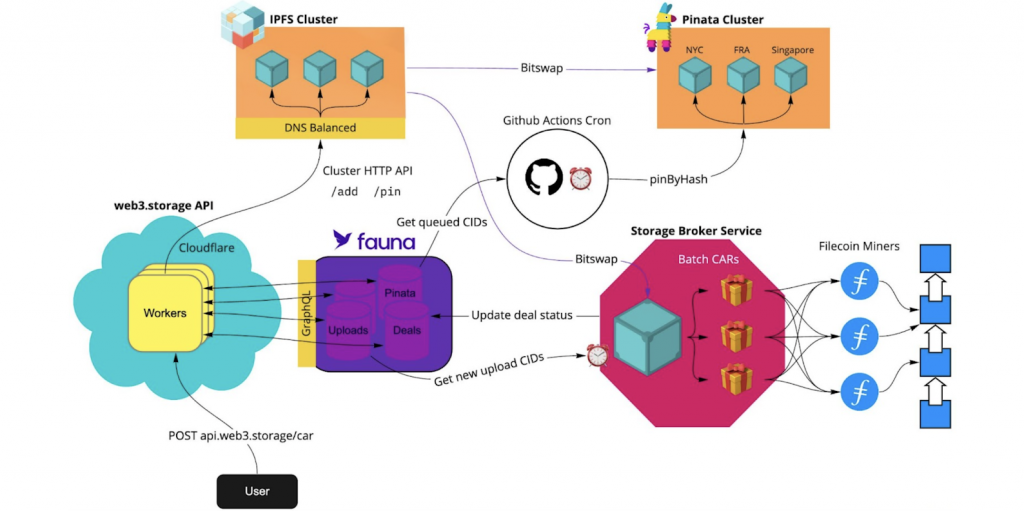
Blockchain Storage – What it is and How to Use Blockchain as Storage – Summary
In today’s article, you learned how blockchain and storage go together and what blockchain storage is. You now know that most blockchains only store essential data, such as transaction hashes and smart contracts. However, you’ve also learned that there are specific blockchains focusing on the “blockchain as storage” aspect. Also, you had a chance to find out the gist of the blockchain storage problem. We also explained where blockchain data is stored. This is where you discovered the leading blockchain data storage solutions, and we took a closer look at IPFS and Filecoin. Lastly, we introduced you to a highly useful blockchain storage tool – Moralis’ IPFS API. As such, you are now ready to start utilizing IPFS without breaking a sweat or the bank.
Moving forward, we recommend you explore all the links provided in this article. By doing so, you can take on some excellent tutorials that will teach you how to use the aforementioned tools. Of course, remember to explore other blockchain development topics that await you on the Moralis YouTube channel and the Moralis blog. For example, some of the latest articles focus on ethers.js dapp development, token metadata, using a Web3 JS call contract function, and much more.
Additionally, make sure to consider becoming blockchain certified by enrolling in Moralis Academy. If you want to go full-time crypto, this will significantly increase your chances. While many courses are waiting for you on the other side, we believe starting with blockchain and Bitcoin fundamentals is the best way to go.
